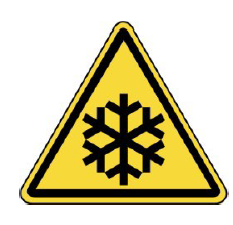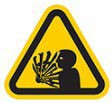Dry Ice Tip Sheet
Tip Sheet
Dry Ice is the solid form of carbon dioxide that is available in flakes, pellets, or blocks form and is non‐combustible. It is most often used for rapid cooling of materials or shipping biological samples. Dry Ice poses unique hazards to those who may work with or around it. Users should contact their Department Safety Representative or @askEHS if they plan on shipping materials on Dry Ice with questions before beginning work.
Training is required prior to shipping with Dry Ice. See the EHS website link for more details: Instructions Enrolling DOT Certificates.
Hazards
Carbon Dioxide, Solid is NOT considered a Hazardous Substance by the 2012 OSHA Hazard Communication Standard (29 CFR 1910.1200). However, it is classified as a Dangerous Good for transport purposes under the Department of Transportation (DOT).
The precautions associated with handling this material are as follows:
| Hazard Symbols | Types of Hazards |
|---|---|
|
Contact Hazard: At -109 °F (-79 °C), skin contact with Dry Ice can lead to severe frostbite; skin cells freeze and become damaged very quickly. |
|
|
Asphyxiation Hazard: Dry Ice will sublime (change from solid to gas) at any temperature above -109 °F. This releases potentially substantial volumes of CO2 (1 pound solid = 250 liters gas) causing dizziness, headaches, difficulty breathing, loss of consciousness and death. This is especially of concern in nonventilated or confined spaces. |
|
|
Over-pressurization Hazard: Due to the rapid emission of large volumes of CO2 gas, any Dry Ice that is stored in a closed container can pressurize the container. Given enough time at normal room temperature, such a container may violently rupture if the gas is not able to escape. |
Precautions
Before starting work:
- Review the safety data sheet: Dry Ice (Carbon Dioxide, Solid) [CAS No. 124-38-9]
- Be familiar with emergency procedures.
- Be familiar with materials Dry Ice is incompatible with.
- Use only the quantity needed at the time.
During work:
Perform all operations in a well-ventilated area. Avoid inhalation.
Avoid skin contact with Dry Ice. This can lead to frostbite. Use appropriate personal protective equipment (PPE):
-
Wear closed-toed shoes that cover the feet.
-
Wear a lab coat or a garment covering the ankles.
-
Wear appropriate eye protection, including goggles and/or a face shield. Use tongs to handle Dry Ice when possible.
-
Use loose-fitting, thermally insulated gloves (e.g., leather or cloth) to manually handle Dry Ice. Nitrile exam gloves do not provide enough protection. If a nitrile glove material comes into contact with Dry Ice while you are wearing it, it may freeze to your hand and be very hard to remove. Never handle Dry Ice with bare hands.
-
Gloves must be thoroughly inspected prior to each use. Do not put on or continue to use damaged gloves.
Use materials and containers appropriate for Dry Ice use and remain aware of potential incompatibilities:
-
Never store Dry Ice in a tightly sealed container, or any container with a screw-top lid that will not vent. Styrofoam is an appropriate storage material since it is both insulated and not airtight. When it sublimates to carbon dioxide gas, the gas pressure greatly expands. This expansion will cause an airtight container to expand and possibly violently rupture.
-
Do not store Dry Ice in metal, plastic, or glass containers, unless the container is specifically rated for use with Dry Ice. The extremely cold temperature is likely to fracture or break these containers.
After completing work:
- Disposal:
- Place in a well-ventilated location, such as a fume hood, to allow the remainder of the ice to sublimate.
- Never dispose of Dry Ice in a trash can or chemical waste container.
- Never dispose of Dry Ice in a sink, toilet or other fixture; the temperature difference can damage the plumbing.
- Return container to storage:
- Always store Dry Ice in a well-ventilated location.
- Do not store large quantities.
- Do not store containers inside of a fume hood without ensuring proper airflow through the hood.
- Do not store/use Dry Ice in confined areas with limited ventilation. This includes cold rooms, walk- in refrigerators, environmental chambers, and refrigerator/freezers.
- Do not leave Dry Ice unattended in open areas.
- Store in original containers or other appropriate containers.
- Store away from incompatibles.
- Wash hands and forearms thoroughly with soap and water before leaving the lab.
Emergency Procedures
If you see or receive a container that is swollen or bulging, contact CU Police to report an emergency. Do not try to release pressure in the container.
Call 911 (from a landline) or (607) 255-1111 from a cell phone.
First Aid
Emergency treatment if skin or eyes come into contact with cryogenic liquid or vapor is as follows:
- If Dry Ice comes in contact with the skin or eyes, flush the affected area with generous quantities of cold water. Never use dry heat. Splashes on bare skin cause a stinging sensation, but, in general, are not harmful.
- If clothing becomes soaked with liquid, it should be removed as quickly as possible and the affected area should be flooded with cold water as above.
- Where clothing has frozen to the underlying skin, cold water should be poured on the area, but no attempt should be made to remove the clothing until it is completely free.
- If inhalation of the cold vapors has occurred, move the person to warm, fresh air. In this case, the person may be suffering from frostbite of tissue in their throat and lungs, but also asphyxia.
- Do NOT rub frostbitten skin as tissue damage may occur. Place in a warm bath that is not above 105°F (40°C).
Submit an Injury/Illness report on the Cornell EHS website: Incident Reporting.
Spill Response
- If spilled, Dry Ice will sublimate to carbon dioxide. The gas is heavier than air and is extremely cold. It and will briefly accumulate in low areas until it warms and equilibrates with the air. Open the room, or increase ventilation by opening the fume hood sash, if a large amount has spilled or if the room is un-ventilated.
- For technical assistance contact (607) 255-1111.




